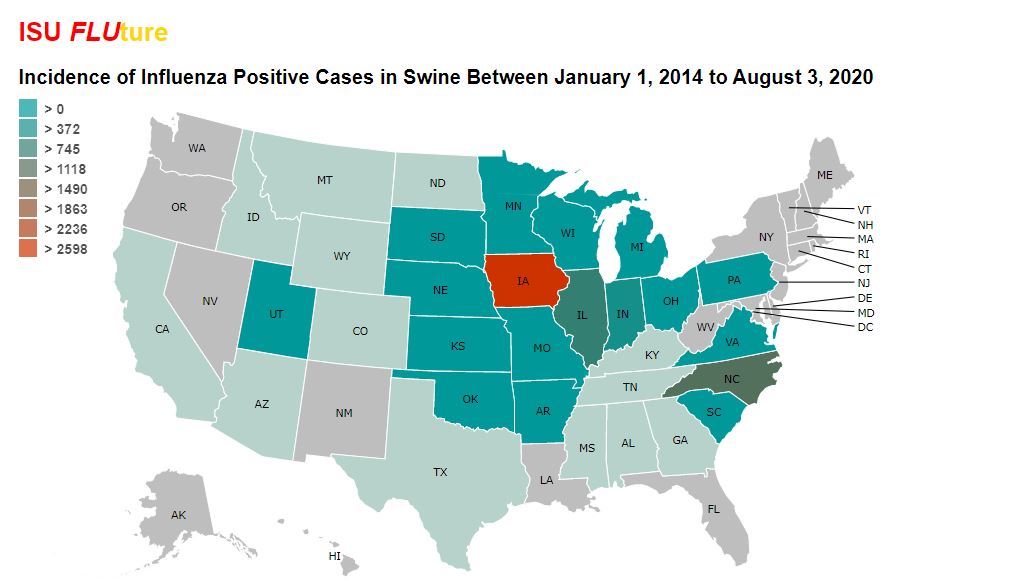



Iowa State's VDL is monitoring new and current swine flu strains
Iowa State's Veterinary Diagnostic Laboratory routinely tracks circulating and new influenza A viruses present in pigs.
Phillip Gauger, an associate professor of veterinary diagnostic and production animal medicine who leads influenza testing at the Veterinary Diagnostic Laboratory, said the lab routinely tracks influenza A viruses present in pigs. Gauger said a new strain prevalent among pigs in China likely wouldn’t pose a significantly greater threat to humans compared to strains currently circulating among U.S. pigs should the new strain appear in the United States.
“Influenza is one of the primary respiratory diseases in swine, and producers are concerned about the health of their herds and the economic burdens caused by disease,” Gauger said.
Pork producers routinely monitor the specific strains of influenza present among their operations to inform health control measures and decisions on vaccine use, Gauger said. Flu vaccines are used primarily on breeding farms to mitigate clinical disease in the sow farms and to confer maternal immunity to piglets, he said.
Practicing veterinarians send samples to the Veterinary Diagnostic Lab for sequencing, which allows the veterinarians and pork producers to identify specific influenza strains circulating in their herds. Gauger said there are three subtypes of influenza among U.S. pigs: H1N1, H1N2 and H3N2.
The Veterinary Diagnostic Lab conducts around 30,000 influenza tests on submitted samples annually and sequences individual strains in over 1,000 positive tests every year. The lab tracks 16 different genetic flu strains from those three subtypes and posts monitoring data on the lab’s FLUture website. The publicly available data allow veterinarians, swine producers and researchers to identify trends that help them make better decisions regarding the health of their herds.

© ISU FLUture
“From the genetic perspective we have a pretty good handle on what’s out there,” Gauger said. “Through collaborative efforts of practicing veterinarians, pork producers, veterinary diagnostic laboratories, and the USDA, the U.S. arguably has one of the most extensive systems for monitoring influenza in domestic pig herds anywhere in the world.”
The ISU Veterinary Diagnostic Laboratory is a Level 1 laboratory in the USDA’s National Animal Health Laboratory Network.
New strain warrants monitoring but not a cause for alarm
In recent weeks, a new influenza variant dubbed G4 EA H1N1 has circulated among Chinese swine herds. The variant contains genetic segments similar to the H1N1 strain that caused a pandemic in 2009, but Gauger said the same can be said of other flu strains and that fact alone isn’t cause for alarm. Additionally, the variant has not been confirmed in the United States, and Gauger said the monitoring conducted at facilities like the ISU Veterinary Diagnostic Laboratory would detect the variant if it infected pigs in the U.S.
“We feel like it’s not any more of a concern than any other strain that can circulate in swine at this time,” Gauger said. “This particular strain in China doesn’t seem to pose a vastly different threat than strains that we’re already monitoring. It’s something that we’ll watch, and the Iowa State Veterinary Diagnostic Laboratory has the ability to detect this strain if it entered the U.S.”
Gauger noted influenza strains can undergo reassortment, or the process by which flu strains exchange genetic material. Reassortment and other changes to the genome could allow IAV strains in swine to become infectious among humans, though Gauger said virtually any strain has that potential, and it’s difficult to predict when or if that might occur. The new strain detected in China should not be a cause for panic for swine producers or consumers, Gauger said, though it’s important to stay aware and implement effective influenza monitoring and biosecurity measures on farms regardless.
Gauger also stressed that influenza is a respiratory virus in swine that affects only the respiratory tract. Accordingly, it doesn’t contaminate meat or threaten the safety of the food supply.
Image reference:
Zeller, M. A., Anderson, T. K., Walia, R. R., Vincent, A. L., & Gauger, P. C. (2018). ISU FLUture: a veterinary diagnostic laboratory web-based platform to monitor the temporal genetic patterns of Influenza A virus in swine. BMC bioinformatics, 19(1), 397. (data retrieved 03 Aug, 2020).









